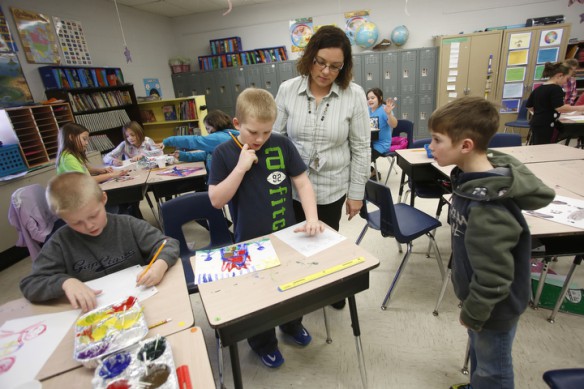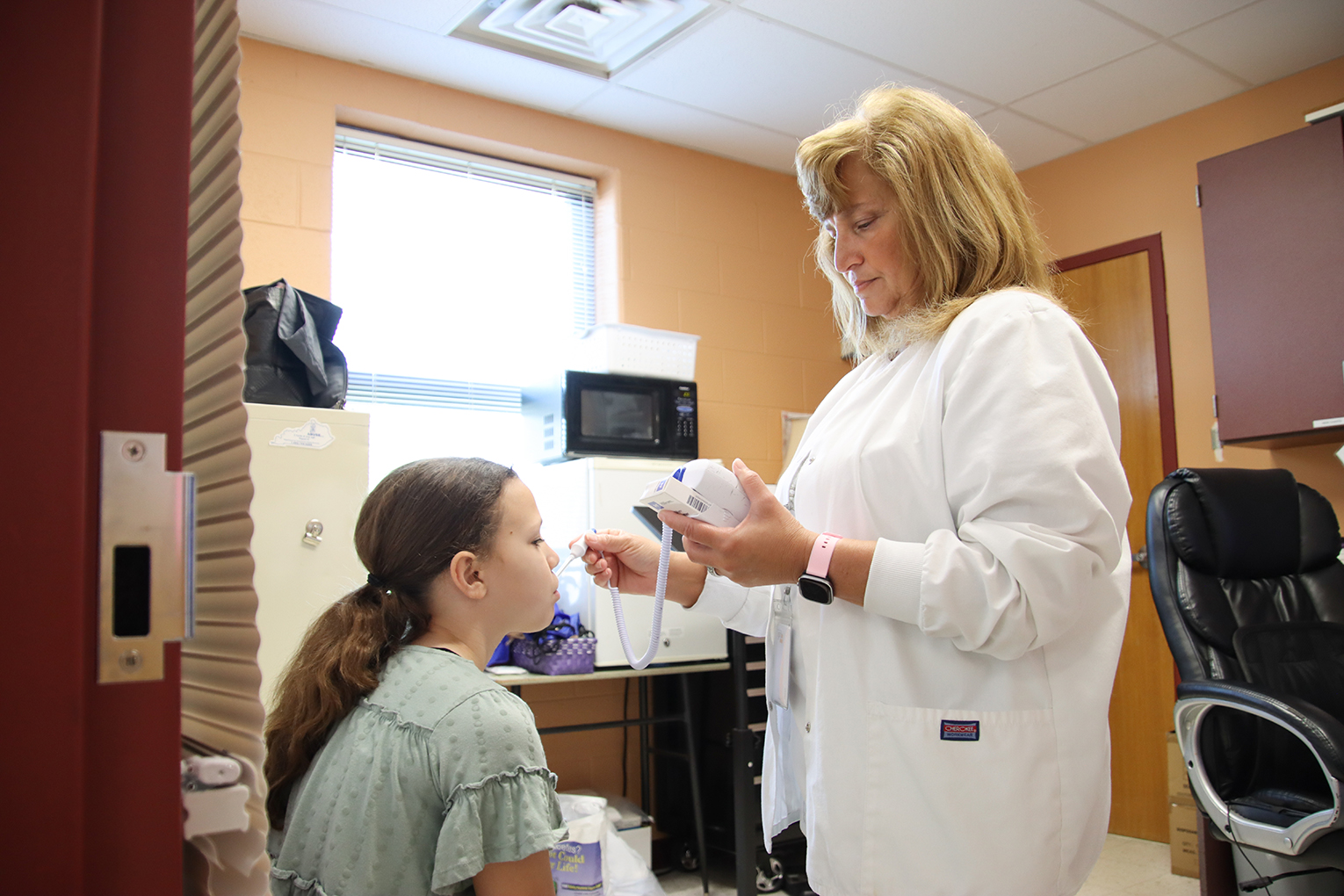
Second-grade teacher Mary Fryer looks over Doug Hogan’s painting of rain putting out fire during a class at Clay Elementary School (Webster County). As part of their aboriginal art project, students wrote short stories to go along with their paintings.
Photo by Amy Wallot, Jan. 28, 2015
By Brenna R. Kelly
Brenna.kelly@education.ky.gov
Several of Crystal Harris’ 2nd-grade students now turn their papers in with their names written across the top in Chinese characters.
They are in Asia, at least for this year. Next year, in 3rd grade, they will move to Australia.
By the time students leave Clay Elementary after 6th grade, they will have traveled around the world, learning about people, culture and language on all seven continents without ever leaving Kentucky.
“The whole thing is to make them see that there’s a whole world outside this little bitty, rural town that a lot of kids never get out of,” said Harris, who is incorporating Asian culture in her planned lessons.
The Webster County school is one of 14 elementary and middle schools across the state already taking steps to increase students’ understanding of the world. The schools, which each received a $15,000 grant to help implement global competency into their curriculum, will become models for schools across as they prepare for the World Language and Global Competency Program Review.
“When people think about global competency, they think I have to have a full-time world language teacher,” said Kelly Clark, the Kentucky Department of Education’s project manager for global competency. “It includes language, but it’s more about sharing cultures in a deep and meaningful way through all content areas.”
Global competency and world language will become part of elementary and middle school’s program review in the 2016-17 school year. It will be part of the program review in high schools next school year.
The effort is part of Senate Bill 1 (2009) which mandated new more rigorous standards in hopes of making sure Kentucky students will be ready to compete in the 21st century economy and, in turn, strengthen the long-term economic health of the state.
More than 21 percent of Kentucky jobs in 2011 were tied to international trade, according to a 2013 report by Business Roundtable. In 2012, Kentucky-made products were sold in 201 international markets which generated $23.2 billion for the state’s economy, the report stated.
Students need to be prepared to operate in a global marketplace even if they never leave Kentucky, Clark said.
“We’re not just competing with kids from Tennessee or Wisconsin, we’re competing with kids from South Korea, and Germany and India,” she said. “We need to be benchmarked not just across the United States but our standard needs to be a world-class standard.”
The department is working with the 14 pilot schools to help create a roadmap that the rest of the state’s elementary and middle schools can follow, Clark said.
The pilot schools are working with VIF International Education, a North Carolina-based company which provides international education programs and resources. Teachers and principals participate in online professional learning that shows them how to make global connections across all content areas.
A sample VIF lesson about water issues around the world shows how one global issue can be discusses as science, math, English/language arts, world language and social studies, Clark said.
“We don’t want more Taco Tuesday’s that’s really not the intent,” she said. “Flags in the hallway are wonderful, but they are meaningless unless you build some sort of content around them.”
Schools are also encouraged to form partnerships with the community and work with the global companies that are based in almost every county in the state.
Campbell County, which also received the grant, is planning to connect with the diverse faculty at nearby Northern Kentucky University said Julie Kuhnhein, the district’s teaching and learning leader for secondary.
“We have big plans in terms of what we want to do,” Kuhnhein said. Another idea is to expand a world culture fair already being held at one school into a districtwide event. The district also plans to reach out to several families who speak English as a second language including several native Arabic-speaking families at Cline Elementary, to engage them in the district’s efforts The district’s high school also piloted the World Language program review for high schools and hopes to expand more world language offerings to middle school students.
World language at the middle school and elementary levels is a challenge because most world language teachers are trained to teach high school students, Clark said. And when schools do find a world language teacher, they often don’t have the money to hire one.
Clay Elementary Principal Clay Mattingly said that is the situation at his school. So he’s looking for other ways to introduce his students to world languages, such as Spanish videos produced by Kentucky Educational Television.
“There are elements of world language that we can embed in our regular day,” he said. “It’s really challenging us to add global thinking to what we already do.”
To jump start the school into global thinking, teachers and administrators assigned each grade a continent. Then teachers started looking for tie-ins to use in their lessons.
Arts and Humanities teacher Amanda Jones said she plans to find artists, objects or dances from each continent as a way to learn about the culture. For example when students paint 3D sculptures, it will be as a sculpture from South America that they have studied.
“It’s forcing me to give them more exposure and in turn it’s making me a better teacher,” she said.
Harris started by teaching her 2nd-graders the elements of culture, such as symbols, language and values, and then added those elements to her lessons.
When students read about Helen Keller and learned about Braille and sign language, they also learned about Chinese characters and how to write their names in Chinese. When they read “Cinderella”, they also read a Chinese version called “Yen Shen” then compared and contrasted the books.
“Every week, whatever story we’re doing, I just try to see if there is any way to make it global,” Harris said.
The book “Schools Around the World” led to a discussion on the differences between American and Chinese schools. When students quickly judged American schools better because Chinese students had to wear uniforms, Harris explained to her students “that different is not bad.”
Becoming globally competent isn’t just about learning what other people eat or what language they speak, she said.
“Exposing students to different cultures teaches tolerance and having compassion for other people,” Harris said, “and how to respect other people’s culture.”
MORE INFO …
Kelly Clark Kelly.Clark@education.ky.gov
Clay Mattingly Clay.Mattingly@Webster.kyschools.us
Amanda Jones Amanda.Jones@Webster.kyschools.us
Crystal Harris Crystal.Harris@Webster.kyschools.us
Julie Kuhnhein Julie.Kuhnhein@Campbell.kyschools.us




Extremely proud of our Webster County Schools for their movement in embedding global competency into the curriculum.